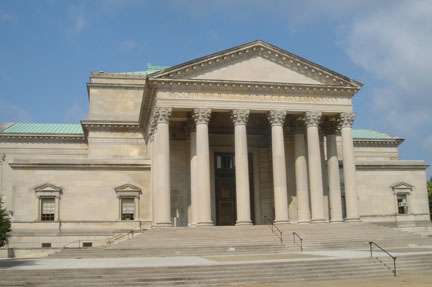Winans Mansion
1217 Saint Paul Street

One of a few–and possibly the only fully intact late-nineteenth-century urban mansions designed almost exclusively by acclaimed by New York architect, Standford White of McKim, Mead & White, the Ross Winans House at 1217 St. Paul Street is the epitome of cosmopolitan living in Baltimore. Commissioned by Baltimore millionaire Ross R. Winans, heir to a fortune made by his father in St. Petersburg, Russia, the 46-room, brick and brownstone French Renaissance revival style mansion was built in 1882. The house features fine oak paneling, parquet, leaded glass, Tiffany designed tile and other fine materials throughout. The Winans Mansion has remained a dominant architectural symbol of the neighborhood and has been used as a preparatory school for girls, a funeral parlor, and a doctors’ offices. Baltimore Heritage listed the building on the Preservation Watch List in 2000, after it sat unoccupied for many years. Shortly thereafter, Agora Inc. took control of the building and in 2005 completed a multi-million dollar historic renovation that gained distinction by winning a Baltimore Heritage preservation honor award that year. Agora continues to own the builiding and uses it as offices.
Scottish Rite Temple
3800 North Charles Street

The Scottish Rite of Freemasons began construction of the temple building on north Charles Street in 1930, and the building was opened in 1932. The building was designed by noted architect (and Scottish Rite Mason) Clyde N. Friz and renowned architect John Russell Pope. Friz’s other works in Baltimore include Enoch Pratt Free Library and Standard Oil Building. A nationally renowned architect, Pope designed the Jefferson Memorial, National Archives, National Gallery of Art, and the Masonic Temple of the Scottish Rite in Washington, as well as the Baltimore Museum of Art here in Baltimore. The Scottish Rite Temple on Charles Street is both Italian Renaissance and Beaux Arts Classical in style, with a columned portico based on the Pantheon in Rome. Eight 34-foot columns with Corinthian capitals provide the entrance facing Charles Street, and the entry consists of two massive bronze doors. The Scottish Rite Masonic order continues to occupy the building. After considering selling the building for demolition, the Masons are recosidering options. The building was added to the city’s list of historic landmarks in 2009 with the support of Baltimore Heritage and any future plans for the buildings must meet the city’s strong preservation guidelines.
Castalia
The first headmaster of the Calvert School, Virgil Hillyer, built Castalia between 1928 and 1929, naming it after the spring at the foot of Mount Parnassas in Italy that is said to have been the inspiration for the muses. The prominent Baltimore architect Francis Hall Fowler was the architect of this Italian villa-inspired house. In 2006, the Calvert School acquired the building and proposed to demolish it for an outdoor amphitheater. The Tuscany Canterbury Neighborhood Association led the effort to save the building, with Baltimore Heritage filing a successful nomination for the building to be added to the city’s historic landmark list. The building is now on the landmark list and the Calvert School has begun plans to preserve it for a school-related use.
400 block of West Baltimore Street
The 400 block of West Baltimore Street was the location of the first toll booth of the National Road. The block, across from the Hippodrome Theater, is a mostly intact street wall of historic properties and includes two of the last nine full cast iron fronted buildings still standing in Baltimore (see entry below for cast iron buildings). Most of the buildings on both sides of the block are protected to some extent under city ordinance and are listed as “contributing buildings to be preserved” under a written memorandum of understanding between the city and the Maryland Historical Trust. After plans that called for the demolition of much of the south side of the block were abandoned in 2009, the block has seen significant rehabilitation of its historic structures. On the north side, the anchor corner building has been renovated, and many of the buildings on the south side that were proposed for demolition have now been restored by owners A&R Development Corporation and David S. Brown Enterprises. Baltimore Heritage removed the block from the Historic Preservation Watch List in July 2010 in recognition of the substantial rehabilitation and renovation that has signaled a commitment to retain the historic buildings in this important part of the west side of downtown.
